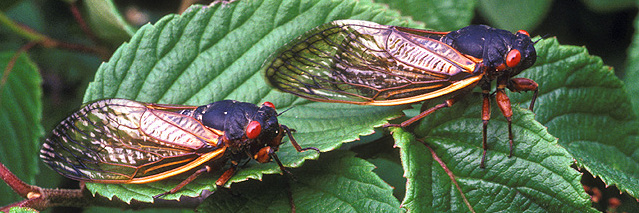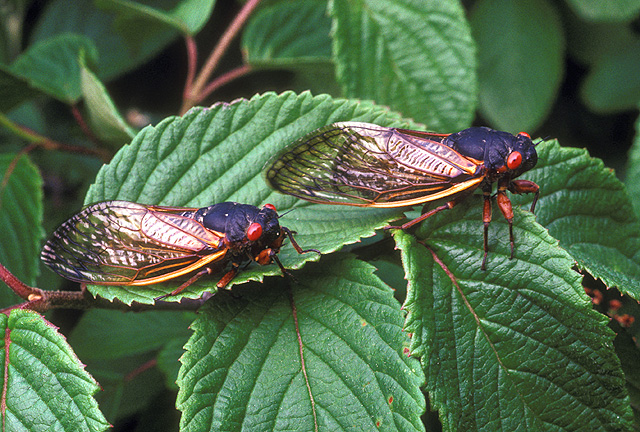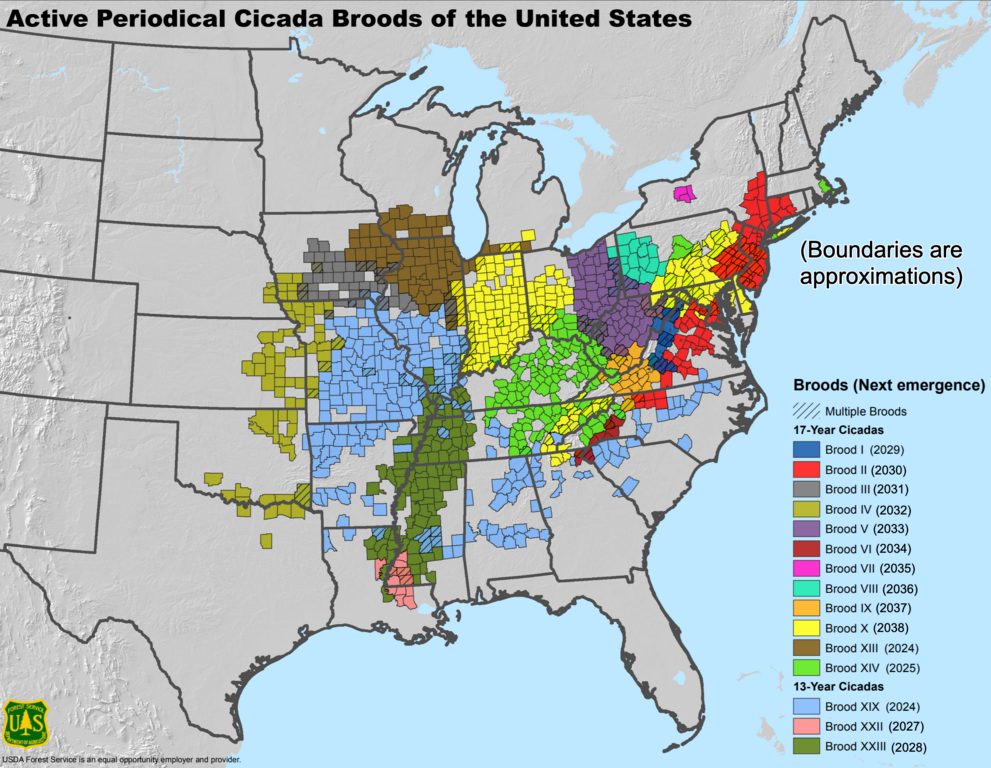Cicadas can be found in thousands of different species around the world, and they usually emerge once a year. However, the Magicicada genus of eastern North America is unique, as its species follow a periodical cycle, emerging either every 13 or 17 years. The members of the Magicicada genus spend 99.5% of their lives underground as nymphs, feeding on fluids from tree roots. Every 13 or 17 years, nymphs become mature, and emerge between late April and early June, depending on latitude. Adult cicadas only live about two months after their emergence. During this period, they mate and lay eggs, which hatch in summer. The nymphs born from these eggs stay underground for another 13 or 17 years, repeating the cycle.
What is even more unique about periodical cicadas is that, for any given location, all the members of the local population have a synchronized development, and they all emerge at the same time, often in huge numbers. Meanwhile, for other cicada species, the adults might emerge while nymphs of the same population are still developing. However, their life cycle is not annual, as they usually live between two and ten years. This means that the “annual cicadas” are not synchronized, and different members of the same species can appear every year.
There are seven species of Magicicada, three of which have a 17-year life cycle, while the other four have a 13-year life cycle. Also, they are divided in different broods, based on the year of their emergence. There are 17 known broods of Magicicada, two of which are now extinct, and they can host different species. These populations often live in different, but adjacent, geographical areas, and in some places various broods might overlap.
Two cicadas of the Magicicada septendecim species, the largest species of periodical cicada with a 17-year life cycle.
The moment of their emergence varies based on latitude, with the southern broods coming out earlier, in late April or early May. The northermost broods instead only emerge in late May or early June. This is because their emergence depends on the soil temperature, which has to be above 17.9 °C. The cicadas first emerge in the evening, as this provides them some hours of protection from diurnal predators. After securing themselves to a vertical surface, they spend about six days completing their final transformation.
Over the following weeks, the cicadas look for a partner. Male cicadas produce a loud noise to attract females, and often members of the same population form aggregations to sing together. As aggregations can have thousands of members, the sound produced by these groups of male cicadas can be extremely loud, up to 100 dB in the immediate vicinity.
This loud noise is also caused by the cicadas emerging in huge numbers at the same time, sometimes with over 300 individuals per square meter. One of the reasons for this mass emergence is to overwhelm predators, as other animals feeding on them can never make a big impact on the number of an entire population of cicadas, as there are just too many. Emerging every 13 or 17 years might be another strategy to avoid predators. Potential predators could develop periodical populations synchronized with the divisors of the cicadas emergence period. Having developmental periods set on prime numbers eliminates this possibility.
According to another hypotesis, the prime-numbered periods might be a way to avoid interbreeding between different broods. This might be a consequence of having extremely long development times. This beneficial trait might be lost by mating with cicadas that do not have it, so some populations might have developed these prime-numbered periods to avoid losing this characteristic.
Different broods of Magicicada usually emerge in different years. However, there might be some cicadas that emerge earlier or later than expected. These are called stragglers, and while they could emerge at any time, usually the ones with a 13-year life cycle emerge four years later, and those with a 17-year life cycle emerge four years earlier.
The most populous brood of cicadas anywhere in the world is the Brood XIII of 17-year cicadas, and they live in northern Illinois and parts of Iowa, Wisconsin, and Indiana. The largest brood by geographical extent is the Brood XIX of 13-year cicadas, which can be found in various locations between Virginia and Oklahoma, but mostly in Missouri, southern Illinois, and northern Arkansas.
Map of the geographical distribution of the broods of Magicicada in the United States.
These two broods will emerge together in 2024, for the first time since 1803. Indeed, as they have periods of 13 and 17 years, which are both prime numbers, they can only emerge at the same time every 221 (13 multiplied by 17) years. The next occurence of this rare phenomenon will be in 2245. However, due to their geographical locations, the two broods will not overlap for the most part. Only an area around central Illinois might see the emergence of both broods together.
So, there are not going to be extremely large amounts of cicadas in the same place, but their geographical extent will indeed be much larger than usual. Scientists are looking forward to study the event, especially in the areas where the broods might overlap, to see if the two populations with different life cycles might be able to interbreed. Another peculiarity of the 2024 event is that members of all seven species of Magicicada will emerge as adults between the two broods, a coincidence that will not happen again until 2037.



